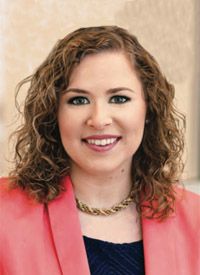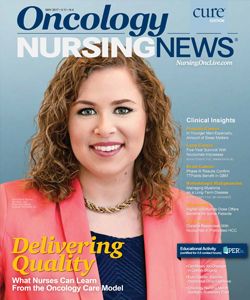Delivering Quality: What Nurses Can Learn From the Oncology Care Model
Nearly 200 practices across the United States are piloting an ambitious new mmodel that focuses squarely on delivering high-quality, lower-cost, patient-centered care.
Anne Marie Rainey, RN, MSN, CHC

Anne Marie Rainey, RN, MSN, CHC
Last summer, nearly 200 oncology practices and 16 health insurance providers embarked on a collaborative new mission to transform the business of cancer care in the United States. Selected by the Centers for Medicare & Medicaid Services (CMS) to participate in a new Oncology Care Model (OCM), they will implement innovative methods of service delivery, care coordination, and financial accountability.
Simply stated, the model's goals are to improve quality and reduce cost. Achieving these goals, however, will require a commitment to, and compliance with, a complex process. The 5-year model is slated to run through June 2021, but its focus on providing accountable, patient-centered care is already a reality for nurses and other healthcare professionals practicing in oncology.
ONCOLOGY CARE MODEL: THE BASICS
The OCM was released in February 2015 by the CMS Innovation Center to improve the access, appropriateness, and coordination of care for Medicare patients receiving chemotherapy through the alignment of financial incentives with practice. The 190 physician groups selected for inclusion were announced on June 29, 2016.
Dawn Hershman, MD, a medical oncologist and leader of the Breast Cancer Program at the Herbert Irving Comprehensive Cancer Center, Columbia University, explained some of the program essentials, including its 6 practice requirements in an interview with Oncology Nursing News®. For each 6-month episode of care, participating practices, which must be Medicare-enrolled and provide chemotherapy, will receive fee-for-services payments in addition to enhanced oncology services payments of $160 monthly.1 Episodes of care are triggered by initiation of chemotherapy and may be repeated as necessary throughout the program term. Performance-based payments will also be awarded according to quality improvement criteria and are intended to guide efficient, effective, and patient-centered collaborative practice.
ONCOLOGY CARE MODEL—6 PRACTICE REQUIREMENTS
- Patient navigation services
- 24/7 patient access to qualified clinician
- Comprehensive care planning incorporating the 13 components of the Institute of Medicine Care Management Plan
- Treatment therapies compliant with nationally recognized guidelines
- Use of certified electronic health record technology
- Data-driven continuous quality improvement
OCM payment models are complicated and not the focus of this article, but it is important to note that financial incentives are not profit-enhancing; they are designed to reward practices that reduce the cost of care while maintaining and/or improving the quality of care delivered.
Participants in the model must demonstrate improvements and are required to report their efforts and results on a quarterly basis throughout the 5 years of the pilot performance reports to the practices outlining achievement measures according to benchmarking standards.
Hershman, although optimistic about the OCM, understands the challenges associated with providing high-value care: “Better quality does not always equate to lower cost.”
Practices may need to add members to the care team, such as patient/financial navigators, and IT and financial experts, thereby increasing existing costs, which may not be completely offset
by monthly service payments. Nonetheless, practices that, “significantly reduce per beneficiary total cost of care will see the largest rewards under the OCM.”2
Although the OCM’s requirements are nonnegotiable, practices are encouraged to optimize the opportunity to receive performance-based incentives through innovation. The biggest
challenge may be meeting the requirements of the model without overspending.
Both oncology practice and payer interest in improving the efficiency and value of cancer care through this initiative surpassed expectations, according to the US Department of
Health and Human Services, which reported it received more than twice the expected number of practice applications. More than 3200 oncologists are now included in the project, covering
an estimated 155,000 beneficiaries.3
Program participants, including commercial payers, are listed on the OCM website.4 Practice participants range from solo oncologists to multiprovider systems located in rural, suburban, and urban settings throughout the United States. Annmarie Flannery, RN, the nurse manager of the OCM program at Montefiore Medical Center in New York City, said that the OCM “shines a spotlight on the notion of change and the importance of evolving the practice of care delivery.” Although practice at Montefiore was aligned with many OCM requirements prior to acceptance into the program, Flannery acknowledges that further improvements, such as adding OCM-specific social workers and enhanced IT data mining, will add to the center’s existing level of high-quality care.
DELIVERING QUALITY
Part of the performance-based payment methodology relates to quality, which in the OCM, focuses on 12 measures divided into 4 domains: (1) Communication and Care Coordination; (2)
Person- and Caregiver-Centered Experience and Outcomes; (3) Clinical Quality of Care, and (4) Patient Safety.5 It is within these domains that oncology nurses do their best and most important work and where innovation finds opportunity.
Diane Baldwin, RN, of Mitchell Cancer Institute, and Anne Marie Rainey, RN, MSN, CHC, of Clearview Cancer Institute, whose centers are both located in Alabama, each have seen how
these measures promote high-value care. The communication/care coordination domain, for example, addresses unnecessary hospital and emergency department (ED) admissions. Baldwin
explained how preemptive interventions by oncology nurse clinical care coordinators make a difference and improve the patient experience.
“Prior to the OCM, we had lay navigators—specially trained individuals from various backgrounds, such as social work, education, or counseling—who helped patients with social support, advanced care directives, transportation, etc. Since then, we have added clinical care coordinators as part of a collaborative effort, and they manage the clinical aspect of care—managing symptoms, triaging patients at home, and arranging same day appointments for hydration or other needs.”
Rainey, who is an OCM project lead, concurs on the important role of care coordinators, but adds that meeting the requirements of the model can be challenging, due in part to added documentation. One positive outcome, said Rainey, pertains to screening for depression, which is 1 of the measures within the person/caregiver—centered experience and outcomes domain.
Prior to the OCM, depression screening happened, “most of the time,” but implementation of the model enhanced awareness. Now they make a concerted effort to routinely screen all
chemotherapy patients, even those who are not eligible for Medicare.
“We make sure we are addressing whatever nuances of their healthcare are important to them,” Rainey explained. Some clinical staff responded to the additional screening mandates by questioning the change. Explaining that not only is depression screening required, but also why—to provide better care—encouraged staff buy-in and helped them to fully engage with the work being done.
The remaining domains (clinical quality of care and patient safety) focus on appropriate chemotherapy regimens for various types and stages of prostate, colon, and breast cancer and
accurate documentation in the medical record of the patients’ current medications.
Baldwin and Rainey agree that although it is still too early in the model to determine how the cost-reduction aspect of the model will work in the long term, they do know that by reducing
unnecessary hospital and ED admissions with early and proactive intervention, they are able to rein in those costs and provide more effective care management for their patients.
Rainey also praises supportive efforts offered by OCM project leaders geared to help facilities as they progress through the model. Participating in focus groups and reviewing released case
studies have been very beneficial for providers in knowing what other practices have found works or does not work well. In this sense, collaboration is more than an OCM requirement; it
is fuel for the trip ahead.
As the OCM pilot continues to evolve and practices find and share their successes, nonparticipating cancer centers, and the care community in general, can benefit from following
their journey, becoming familiar with the model’s key components, and scrutinizing their own delivery of services. Much remains to be learned and gained through creativity, collaboration, and commitment to excellence. As Flannery stressed, “The Oncology Care Model gives us direction with our care and helps us focus on practicing our calling.”
REFERENCES
- Center for Medicare & Medicaid Services. Oncology Care Model. Fact Sheet. go.cms.gov/29cD7az. Accessed April 26, 2017.
- The Advisory Board Company. CMMI’s Oncology Care Model. Published June 20, 2016. bit.ly/2pmB8XH. Accessed April 26, 2017.
- The ASCO Post. HHS Announces Physician Groups Selected For An Initiative Promoting Better Cancer Care. 2016. bit.ly/2p4KUgm. Accessed April 3, 2017.
- Center for Medicare & Medicaid Services. Oncology Care Model. innovation.cms.gov/initiatives/Oncology-Care. Accessed April 26, 2017.
- Center for Medicare & Medicaid Services. OCM Performance-Based Payment Methodology. innovation. cms.gov/Files/x/ocm-methodology.pdf. Published December
- 20, 2016. Accessed March 27, 2017.
- Institute of Medicine. Delivering High-Quality Cancer Care: Charting a New Course for a System in Crisis. bit.ly/2qfEPeT. Accessed April 26, 2017.

Innovative Program Reduces Nurse Turnover and Fosters Development
Published: September 12th 2024 | Updated: September 12th 2024The US Oncology Network (The Network) has developed one of the most comprehensive programs in the nation to support the professional development and retention of new oncology nurses.


